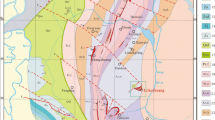Abstract
The Jingtieshan deposit occurs in a Precambrian tectonic-stratigraphic terrane within the Northern Qilian Caledonian Orogen, and is generally considered as a Superior-type iron formation. The deposit is characterized by Fe-Si-Ba and Cu mineralization and consists of two types of orebodies, an upper jasper-barite-iron deposit and a lower copper sulfide deposit. The iron orebodies occur as independent stratigraphic layers concordant within a thick argillaceous succession, and exhibit fine-grained textures and well-developed sedimentary layering. The ores are predominantly composed of specularite and jasper with lesser amounts of magnetite, hematite, siderite, and barite. The presence of barite, hematite and jasper as major components shows that the iron ores were precipitated in a relatively oxidized ocean floor environment. The Cu orebody directly underlies the iron ore and is hosted by chlorite-sericite-quartz phyllite. The Cu mineralization is composed of pyrite and chalcopyrite and is characterized by stockwork. The disseminated and stockwork Cu mineralization is metamorphosed and concordant with respect to foliation, indicating pre-fabric development, i.e. pre-metamorphism, and was probably originally formed by reduced fluids reacting at the base of and within the oxide iron formation. Geochemical data show that the jasper-barite-iron ores, which resemble Superior-type iron formations, have a high input of hydrothermal-hydrogeneous elements (SiO2, av.=56%; Fe2O3t, av.=30%; Mn, av.=0.45%; BaO, av.=16.7%) with minimal terrigeneous input (<15% combined Al2O3, TiO2, K2O, MgO, etc.). The δ34S of exhalative barite varies from 28 to 34‰, which is very heavy with respect to other Late Proterozoic sulfate-bearing deposits, except those of circa 600 Ma in which the sulfides range from 8 to 20‰. The sulfur isotope data indicate that the barite was formed by the mixing of a Ba-rich hydrothermal fluid with sulfate-rich ambient seawater and that the sulfides ores were most probably derived from the reduction of seawater sulfate during subsurface reaction with ferrous iron-bearing minerals. These data are consistent with the jasper-barite-iron deposit forming by hydrothermal exhalative and chemical sedimentary processes on the floor of an ocean basin, and with the Cu mineralization forming by hydrothermal filling and replacement in base of and within the iron formation.
Similar content being viewed by others
Author information
Authors and Affiliations
Additional information
Received: 19 March 1997 / Accepted: 14 May 1998
Rights and permissions
About this article
Cite this article
Sun, H., Wu, J., Yu, P. et al. Geology, geochemistry and sulfur isotope composition of the Late Proterozoic Jingtieshan (Superior-type) hematite-jasper-barite iron ore deposits associated with stratabound Cu mineralization in the Gansu Province, China. Mineral. Deposita 34, 102–112 (1998). https://doi.org/10.1007/s001260050188
Issue Date:
DOI: https://doi.org/10.1007/s001260050188




